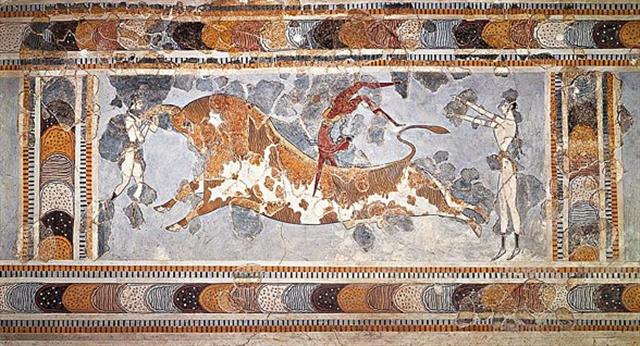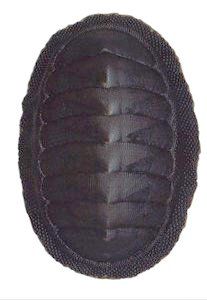261. In Manuscript E we can read how the canoes of Ava Rei Pua and Hotu A Matua were first observed by Nonoma when he was out urinating in the night. I have guessed this detail alluded to the Leo stars below Coxa (θ) which could have been imagined as urine flowing down from his full bladder: ... The rays drink up the little waters of the earth, the shallow pools, making them rise, and then descend again in rain. Then, leaving aside the question of water, he summed up his argument: To draw up and then return what one had drawn - that is the life of the world ...
By adding 16 glyph days to Ca13-9, where Metoro said there certainly (haki) was a hole (pu), we will reach day 249 + 16 = 265, i.e. to the southern spring equinox:
The Sun king surely ought to have arrived to Easter Island at this point in time, after having moved across the equator from the northern hemisphere. ... The canoes of Ava Rei Pua and of Hotu were seen near the (off-shore) islets. On the fifteenth day of the month of October (tangaroa uri) the canoe of Hotu and the canoe of Ava Rei Pua landed. On the fifteenth day of the month of October (tangaroa uri), Nonoma left the house during the night to urinate outside. At this point Ira called out to Nonoma, 'Look at the canoe!' Nonoma ran, he quickly went to Te Hikinga Heru (a ravine in the side of the crater Rano Kau) and looked around. There he saw the double canoe way out near the (offshore) islets, and the two (hulls of the canoe) were lashed together. He ran and returned to the front of the house. He arrived and called into the house: 'Hey you! This canoe has arrived during the night without our noticing it!' Ira inside the house could not see the double-canoe, and presumably this was because he was still half asleep or because its stars were too close to the Sun: Ira asked Nonoma, 'Where is the canoe, which you say is lying out there (in the water)?' Nonoma's voice came back: 'It is out there (in the water) close to the (offshore) islets! There it lies, and the two (hulls) are lashed together.' But there was a twist in the story because Tagaroa uri 15 = October 15 (288) = 265 (September 21) + 23 days. ... The ancient names of the month were: Tua haro, Tehetu'upú, Tarahao, Vaitu nui, Vaitu potu, He Maro, He Anakena, Hora iti, Hora nui, Tagaroa uri, Ko Ruti, Ko Koró ... This twist can be straightened out by assuming the Gregorian calendar at the time of the Pope defined the distance 23 right ascension days as that needed to go down to the time of the Julian calendar, i.e. the number of right ascension days ahead. Indeed confirmation was given by the Pope himself because he launched his new calendar (canoe) in day 288 (= 2 * 12²): ... The Julian calendar day Thursday, 4 October 1582 was followed by the first day of the Gregorian calendar, Friday, 15 October 1582 (the cycle of weekdays was not affected) ... *27 (right ascension days from the time of rongorongo down to Roman times) - *23 = *4 corresponded approximately to the number of precessional days up from the time of Julius Caesar to the Council of Nicaea. ... When Julius Caesar established his calendar in 45 BC he set March 25 (3-25) as the spring equinox. Since a Julian year (365.25 days) is slightly longer than an actual year the calendar drifted with respect to the equinox, such that the equinox was occurring on about 21 March in AD 300 and by AD 1500 it had reached 11 March. This drift induced Pope Gregory XIII to create a modern Gregorian calendar. The Pope wanted to restore the edicts concerning the date of Easter of the Council of Nicaea of AD 325 ... I.e. from the time of Caesar the stars rising heliacally in 'September 21 (265) had advanced with 23 days to about °October 15 (288, *208) and since then with another 4 days to right ascension day *212. This perspective illuminates the correlation between the beginning of side a and the beginning of side b:
According to the Gregorian calendar the beginning of the equinoctial year was at March 21 (0h). The corresponding cardinal spring point on Easter Island was September 20 (*183) = 80 (March 21) + 183 = 263. ... Ecclesiastically, the equinox is reckoned to be on 21 March (even though the equinox occurs, astronomically speaking, on 20 March in most years) ... The beginning of side b on the C tablet was 393 days (glyphs) later, which had to be day 263 (September 20) + 393 - 366 = 290 (October 17). The corresponding day north of the equator should therefore be day 290 - 183 = 107 (April 17) = April 1 (91) + 16. And η Andromedae (*11) would return to visibility in day 107 (= *11 + *16 + 80).
In Roman times, 27 precessional days earlier, the corresponding position would have been 107 (April 17) - 27 = 80 ('March 21). Notably this day number is 210 (= 420 / 2) less than 290 (= 10 * 29).
... They tightly swathed the broken body in linen bandages, and when they performed over it the rites that thereafter were to be continued in Egypt in the ceremonial burial of kings, Isis fanned the corpse with her wings and Osiris revived, to become the ruler of the dead. He now sits majestically in the underworld, in the Hall of the Two Truths, assisted by forty-two assessors, one from each of the principal districts of Egypt; and there he judges the souls of the dead. These confess before him, and when their hearts have been weighed in a balance against a feather, receive, according to their lives, the reward of virtue and the punishment of sin ... Anciently when there was no zero sign (0) they understood that 42 assessors alluded to day 420 (24 February) = 55 (February 24) + 365.
... The dot is also used for another purpose, namely as one of the ten fundamental figures of the decimal system of notation, or the zero (0 1 2 3 4 5 6 7 8 9). It is still so used in India for both purposes, to indicate the unknown quantity as well as the nought. With us the dot, or rather its substitute the circle (0), has only retained the latter of its two intents, being simply the zero figure, or 'the mark of position' in the decimal system. The Indian usage, however, seems to show how the zero arose, and that it arose in India. The Indian dot, unlike our modern zero, is not properly a numerical figure at all. It is simply a sign to indicate an empty place or a hiatus. This is clearly shown by its name sunya 'empty'."
|
||||||||||||||||||||||||||||||||||||||||||||||||||||||||||||||||||||||||||||||||||||||||||||||||||||||||||||||||||||||||||||||||||||||||||||||||||||||||||||||||||||||||||||||||||||||||||||||||||||

















